 Minister's Mandate Letter Calls to Improve and Upgrade Spray Lakes Road in Kananaskis
Minister's Mandate Letter Calls to Improve and Upgrade Spray Lakes Road in Kananaskis
Rocky Mountain Outlook
Cathy Ellis
KANANASKIS COUNTRY – Banff-Kananaskis MLA Sarah Elmeligi wants the province to pump the brakes on infrastructure improvements, including upgrades to a gravel highway in Kananaskis Country until there is proper public consultation.
In a Sept. 17 mandate letter from Premier Danielle Smith, Alberta Parks Minister Todd Loewen was told to continue investments in trail upgrades in Kananaskis Country, including a plan to “improve and upgrade” Highway 742 – also known as the Smith-Dorrien or Spray Lakes Road – along with parking, facilities and trail infrastructure there.
Despite several attempts to find out if “improve and upgrade” means paving the 70-km gravel road from south of Canmore to Kananaskis, passing through Bow Valley Wildland, Spray Lakes and Peter Lougheed provincial parks, the ministry has ignored the Outlook's requests.
“It’s hard to predict how a mandate letter will unfold and so I look forward to robust public consultation processes around what these infrastructure improvements are going to be in Kananaskis and Canmore,” Elmeligi said.
There have been some calls over the years to pave Spray Lakes Road, but others have argued the road should remain a gravel highway in order to limit the number of vehicles travelling into the remote area where cell service is limited.
The area is popular for climbing, hiking, wildlife watching, swimming, fishing, paddle boarding, boating and camping, but is also a critical area for a host of wildlife species from bears, wolves and cougars, to elk and moose and more.
Elmeligi, a former park planner in Kananaskis Country for Alberta Parks, said the original intent under park management plans was for Highway 40 to be the main corridor for tourism infrastructure and campgrounds while the Smith-Dorrien area was to be a quieter place for people and wildlife.
“We will have some recreation opportunities, but we really wanted to keep this place a lower level of human use so that people can have more of a wilderness experience and that wildlife can have more habitat security,” she said.
“When I see in a mandate letter there will be upgrades to Highway 742, it does make me question how will that objective of leaving Highway 742 as more of this quiet recreation space, how will that be addressed.”
Loewen’s mandate letter also directed him to continue implementing the province’s previous commitment to build more than 900 campsites by 2033, including more than 300 of those to be built by 2027.
In addition, he was ordered to continue with the expansion of trails, campsites and other public land use opportunities by entrepreneurs and other organizations, including improving infrastructure and services in Kananaskis Country and Canmore.
Elmeligi said what is missing in the mandate letter is any kind of reference to a visitor use management strategy.
“All of the concerns that come up around infrastructure in Kananaskis and Canmore and trails and campsites and public land use opportunities and upgrades… it all comes down to how many people, where are they going and what are they doing?” she said.
“All of that really needs to be addressed in some kind of visitor use management strategy because when we are not strategic about these things we make mistakes, and the Bow Valley has learned over decades the consequences of not being strategic about tourism and recreation, development and planning.”
Elmeligi said there is definitely a need for new campsites – and she’s disappointed more haven’t come online yet – but the challenging conversation happens when considering where the new campsites are to be located.
“Are we making sure that we’re putting them in a place that makes sense for wildlife habitat and connectivity and also a high-quality visitor experience, “ she said.